Barrios Tropicales: The Making of Green Neighborhoods
In Latin America, a mix of public and private investment has created tropical urban settings.
Walking through parts of Medellin feels like walking through a jungle. Sure, it’s a big developing world city with lots of concrete, but in famed neighborhoods like Laureles and Poblado, one is treated to an array of verdant green fauna along sidewalks, balconies, and public parks. It’s a common aesthetic within wealthy neighborhoods of other big Latin American cities, enough that I’ve come to coin a term for them: barrios tropicales, or tropical neighborhoods.
I found 13 barrios tropicales throughout my LatAm travels, but there’s likely more I didn’t see. There are four criteria needed to be such a neighborhood:
- traditional urban design, defined by mixed uses, minimal setbacks, and historic architecture.
- streets designed for all kinds of traffic (walking, bikes), not just automobiles
- a clean, safe, and cosmopolitan neighborhood for both residents and tourists.
- most importantly, a tropical public and private realm
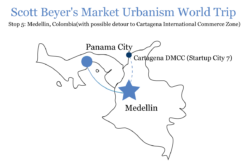
Laureles, which is on Medellin’s west side, fits the bill. The neighborhood began in the 1930s with a visionary plan from urbanist Pedro Nel Gomez, who wanted it built on a circular and transversal grid inspired by Paris. It was supposed to have meadows, fountains and gardens, envisioned as a pastoral escape from the gritty urban center for Colombia’s working class (the original proposed name was “The Citadel of the Employee”). However it attracted wealthy residents and was renamed Laureles, after the laurel trees in the area, and is now one of Medellin’s most exclusive areas.
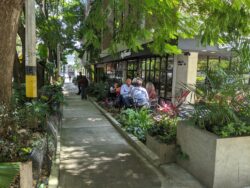
Travel commentators praise the neighborhood for its greenery, with one on Youtube calling it a “lush green suburb.” Another says the plants and trees “gives a perspective of not being in just a gray city.” Another barrio tropical in Medellin, just up the mountain, is Poblado.
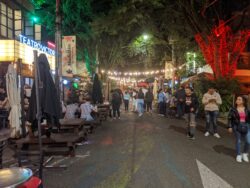
Like with other LatAm barrios tropicales, the ones in Medellin became tropical due to a mix of public and private investment.
For example in Laureles, many of the verdant parks, boulevards and streets date back to the original neighborhood plans. But some have been more recent, such as a city initiative to fight the urban heat island effect by building green corridors
Medellin created 30 green corridors along 18 roads and 12 waterways. They planted over 8,300 trees and 350,000 shrubs, including native trees, tropical plants, bamboo and palms. The corridors soak up pollution, create shade, and create havens for wildlife. The program is maintained by 107 people from disadvantaged communities that were trained as gardeners, and some of their work extends through Laureles.
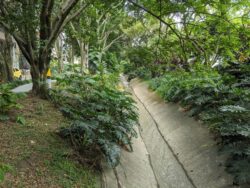
But another component of barrios tropicales comes from the private sector. Commercial storefronts and residential buildings, aware that they are competing for upscale clients in these areas, bolster their look with hanging balcony gardens, planter boxes and ivy-covered walls. There is even a Spanish phrase for the “mini-forests” that building owners plant in their front yards as a status symbol.
In Laureles, Poblado, and several other Medellin neighborhoods, this public and private effort makes the neighborhood feel like a jungle, which is not often found in cities.
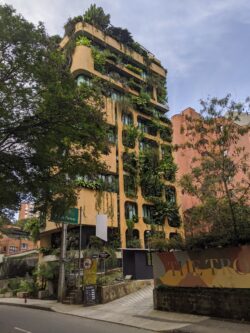 While Medellin had the most barrios tropicales of any LatAm city I visited, others had their own unique features. In Rio de Janeiro, the Leblon neighborhood placed this aesthetic along the beach, helping explain why it has among LatAm’s highest real estate values. Mexico City’s Condesa neighborhood mixes the aesthetic with its historic art deco building stock. Some barrios tropicales, such as Palermo Soho in Buenos Aires, are not technically in tropical climates, but still achieve the look by planting trees sooner associated with the Northern Hemisphere, such as London Planes. (For a full barrio tropical list, see my Facebook post).
While Medellin had the most barrios tropicales of any LatAm city I visited, others had their own unique features. In Rio de Janeiro, the Leblon neighborhood placed this aesthetic along the beach, helping explain why it has among LatAm’s highest real estate values. Mexico City’s Condesa neighborhood mixes the aesthetic with its historic art deco building stock. Some barrios tropicales, such as Palermo Soho in Buenos Aires, are not technically in tropical climates, but still achieve the look by planting trees sooner associated with the Northern Hemisphere, such as London Planes. (For a full barrio tropical list, see my Facebook post).
Will the U.S. ever have barrios tropicales? Much of the South has a sub-tropical climate and could technically pull it off, and some locales are trying, albeit with the temperate deciduous forest biome that covers most of the U.S. Some cities want to create “urban forests” to fight rising temperatures.
Washington, D.C. budgeted over $100 million to plant trees, with the goal of covering 40% of the city. Officials say it would save business and residents over $3.5 million in energy costs. However, they have a difficult time reaching their goal. Property owners are removing trees to make way for new construction, and the city is running out of public space to plant more.
In 2007, Seattle planned to cover 30% of its city with trees. They almost reached that goal, but their canopy decreased by 1.7% in 2021. The problem, said an official, is that Seattle’s population increased, which led to more construction projects for utilities, transportation, and other infrastructure.
The federal government wants more cities to plant trees. The Inflation Reduction Act gave $1.5 billion to the U.S. Forest Service’s Urban and Community Forestry Program.
But no matter the level of government funds spent, the barriers to a U.S. barrio tropical are mainly cultural. Many private property owners don’t see the value-add of urban forestry, whether it’s them or the public that is footing maintenance costs. And even if a neighborhood did commit to the tropical look, most in the U.S. still haven’t achieved criteria 1 through 3 listed above. Coconut Grove in Miami, for example, has the tropical botany but not the urban public realm, functioning more like a car-oriented leafy suburb.
The barrio tropical aesthetic is worth it though. Greening the landscape has made international destinations of many LatAm neighborhoods. This act of public and private interests working together has the economic benefit of increased property values and a much more obvious lifestyle benefit.
All images credited to Scott Beyer and The Market Urbanist.
Catalyst articles by Scott Beyer | Full Biography and Publications
